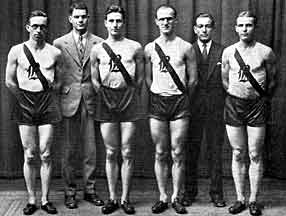
Bates and the Penn Relays
By the end of the 1920s, Bates' string of winning track performances at the prestigious Penn Relays, held each April, had The Bates Student fretting about championship fatigue on campus.
 |
| The 1930 relay team of Wallace Viles '31, Ragnar Lind '30, Russell Chapman '31 and Norman Cole '32; in coat and tie are (left) coach C. Ray Thompson '13 and (right) manager David Spofford '30. |
After the Bobcats' victory in the two-mile relay at the 1930 Penn carnival — the second Bates title in three years, and in the top flight, no less — an editorial in the April 30 Student commented on the subdued celebration on campus: no parade "down-street" to meet the returning team, no bonfire atop Mount David. "Championship after championship comes our way...[and] the thing is beginning to pall," the paper said.
Contrast that sentiment with the ecstasy that enveloped the campus nine years earlier after Raymond Buker '22 won the international two-mile run at the 1921 Penn Relays with a finishing kick that left runners from West Virginia, Purdue and New Hampshire in his wake. In words of the student of May 6, 1921:

Words are feeble, for no use of them has yet been able to picture
the inward emotions we feel, when someone to whom we have allotted a most
difficult task has accomplished it in a manner that is nothing short of
marvelous. As the [Hathorn] bell sounded the joyful news, our first impulse was
that quiet, deep, stirring of the inner man that sends lumps into the throats
and renders us unable to speak. Then comes the rush of pride for our champion
and the pent-up emotions spring into a hilarious burst of enthusiasm and
gratitude for the man who has brought us fame.
Not that overblown prose was limited to the Student; it was the style of the time, and Boston Herald sportswriter Tom McCabe was equally smitten with Buker: "The little Bates lad was great, big, fine, wonderful; all those pulsating things together, and then some."
A year later, Buker again won the two-mile race at the Penn Relays, and a Bates team won its class in the mile relay. The celebration parade on campus, complete with band and a mule (which refused to let a student climb aboard) gathered in front of Parker Hall. Blasts from a cannon announced the parade to the populace as the procession advanced down College Street. "Once on the other side of the hospital," the Student noted in its May 5, 1922, edition, "the snake dance was started and the writhing forms danced gaily from one side to another across the bridge to Auburn."
Back across the river the parade came, continuing down Lisbon Street. "All traffic was suspended and old Bates took possession of the city for the evening," the Student reported. "Red fire illuminated the way, while the sidewalks were jammed with spectators who thoroughly enjoyed the spectacle." Still not spent, the throng returned to campus and paraded to the base of Mount David "where boxes, barrels, hay, sleepers, and various other things were piled high" for a bonfire. The resulting fire nearly torched a professor's home on Mountain Avenue, "melting his tar sidewalk."
The routine was repeated in 1925 after Bates teams won both a Class C and Class B mile relays: Parade gathers in front of Parker; students are "adorned in freakish costumes"; cannon shots announce the parade, which goes down College Street to Sabattus, right onto Main Street, then down Lisbon Street; Mayor Robert Wiseman speaks, promising that "the banner of Bates College with the name of each man on that relay team to be flown from City Hall tower for 10 days." The party winds its way back to Bates, this time to the top of Mount David for a bonfire of logs, where coach Chester Jenkins praised the spirit and pluck of the Bates runners.
Then came Bates' victories in the championship flight of the two-mile run in 1928 and again in 1930 (a dropped baton doomed the team in 1929). The 1930 effort was anchored by Russell Chapman '31, whose 1:54.5 final half mile, securing victory over Ohio State, Harvard, New York University, Army, Georgetown, Cornell, Yale, Columbia and Boston College, was called "brilliant" by The New York Times. (Also on that relay team was Ragnar Lind '30, who would go on to a Hollywood acting career as Jeffrey Lynn.)
In 1930, the campus greeted the news of Bates' relay victory at Penn with a polite nod. Perhaps the winning sports tradition was creating ever-greater expectations. Or, this being the end of the Roaring '20s and the beginning of the Great Depression, perhaps the student culture had become more serious. In any event, after the Hathorn bell announced the team's victory, the Student sports editor was the only one to rush to the steps of Parker Hall and let out a celebratory "war-whoop." In response, a fellow Parker denizen yelled, "Shut up and come to college."
~ by H.J. Burns